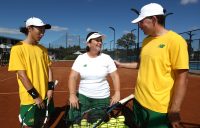Melbourne VIC, Australia, 21 July 2014 | James A. Crabtree, Australian Tennis Magazine
Unlike the professionals, the majority of us don’t have the pleasure of chasing the sun around the globe for our next hit. We have to make do with what is available, braving the elements in the process. Some of us even hang up our racquets for the less desirable months, only to start swinging again once things have improved outside.
But for those who can’t bear the thought of not setting foot on court for the next few months, what should you do besides a reverse rain dance, buying an expensive barometer and staying glued to the Bureau of Meteorology’s website?
Head indoors
Indoor or undercover courts are an obvious solution on days when the heavens just won’t let up. You can stay dry, play without delay and give your phone a rest from obsessive radar updates. Best of all you can wear your favourite tennis shorts while the rain hollers outside; after all it’s of no consequence to you.
There are numerous indoor tennis options throughout Australia. Melbourne Park, home of the Australian Open, boasts 12 indoor courts available for both members and the public. Fortunately for the avid tennis fan, winter programs at their world-class venue stay much the same year round with coaching, a variety of cardio fitness sessions and social competitions all available.
A quick online search will reveal numerous other indoor or undercover venues throughout Australia. Visit tennis.com.au to search for your local options.
Chase the sun
Thanks to the variety of climates that can be found around Australia, it’s possible to find a location where the weather is perfect for tennis no matter what the time of year. While some parts of the country experience typically adverse winters, others enjoy much milder conditions, spurring some to even consider hopping on a cheap domestic flight.
Queensland
Queensland’s climate is not as distinctive as that of Australia’s southern states. The days are invariably mild, fine and sunny with mild to warm temperatures.
“Queensland’s winter isn’t as cold as some other states so it isn’t as hard to motivate players to get outside and play,” says Tennis Queensland’s Carly Rossi. “It is also less likely to rain at this time of year, especially in the north where it is almost impossible to play in summer due to heavy rainfall.”
Furthermore, some of Queensland’s best tournaments are played during the winter months. The Winter Wonderland consists of a collection of popular tournaments held during June, July and August at various metropolitan and regional venues.
And if you find yourself in the Sunshine State, be sure to check out the Queensland Tennis Centre, home of Pat Rafter Arena. Fans can play (for an hourly rate) on the same court that has hosted Roger Federer, Serena Williams, Novak Djokovic, Maria Sharapova, Lleyton Hewitt and Sam Stosur among others. Definitely one to add to your bucket list.
Northern Territory
For people living in the Top End, the dry season (May–October) showcases warm, dry sunny days and cool nights. Temperatures typically range from 21 °C to 32 °C, and the humidity levels are much lower, around 60–65 per cent.
This is when tennis is at its peak, with clubs holding tournaments as well as running leagues. Encouragingly, local club competitions played at night are overflowing with increased participation.
Western Australia
Western Australia’s winter is mild and rain rarely causes prolonged delays with social play abundant on weekday nights and weekend mornings. Tournament play continues year round, with junior tournaments on the weekends and school holidays. Players are still able to enjoy outdoor tennis and many clubs keep their grass courts open. And to top it off, many clubs even boast idyllic settings featuring river or ocean views.
No play today
Not all of us, however, are able to escape winter and if you don’t live close to an indoor facility, sometimes you will have to brave the puddles. But how do you decide when to take on the elements and when to call it a day?
In a tournament the chair umpire or referee determines if a court is fit for play, suspending the match when required. But for the club player the responsibility lies with the players.
Playing outside on a wet court can prove hazardous advises Dr Tim Wood, who is the Australian Open’s Chief Medical Officer. “The dangers of playing on a wet court are slipping and straining muscles – calf, hamstring or quadriceps, or tearing ligaments, particularly ankle and knee. Fractures from rolled ankles are also possible.
“[Also,] if the balls get wet, overload of tendons from hitting the heavier balls is possible leading, for example, to tennis elbow.”
If you find yourself outplayed by the weather it can be a great opportunity to perfect other parts of your game.
Andrew Sun, Director of the Max Tennis Facility in New South Wales, suggests that it is often a struggle to keep his juniors off the court. He admits, “It is commonplace to find a kid pleading with their parent to let them play no matter the weather. Although when the court does become unplayable this is just a good opportunity to focus on the tactical and technical side of the game.”
Get creative
Tennis fanatics are not limited to playing indoors or booking a ticket to a sunnier state. Looking around at what is available locally can also present some weird but wonderful wet weather solutions. Some have been known to play under bridges and train bypasses, even in a basement car park.
According to legend, Sweden’s Bjorn Borg honed his game against his parents’ garage wall, while American Jimmy Connors’ skills were perfected on the skidding hardwood floor of an army barracks basketball court.
Yes, cold weather does have the power to keep even the most hardened players indoors. But remember, there are other options to ensure the winter months don’t come between you and the tennis court.
Decisions, decisions …
Winter need not be a time to pile on extra kilograms while your racquet gathers dust. Extensive tennis programs are offered all year round Australia wide.
Cardio Tennis
This fun, music-fuelled group workout focuses on burning calories, increasing fitness and improving your game at the same time. Visit cardiotennis.com.au for more information.
Casual tennis
Many clubs and facilities offer court hire by the hour and membership is not required. Also, some councils provide free use of public courts.
Leagues/Tournaments
Social or competitive, leagues and tournaments provide players with a great opportunity to get on court regularly.
Coaching
A professional tennis coach will help to improve your game. Coaching is offered through clubs, sports centres and privately.
> Find a coach and start improving your game
Junior tennis
ANZ Tennis Hot Shots is a fun and easy way for your child to learn tennis. Programs are offered through clubs, sports facilities and schools; go to hotshots.tennis.com.au to find your nearest venue.
> Learn more about junior tennis






